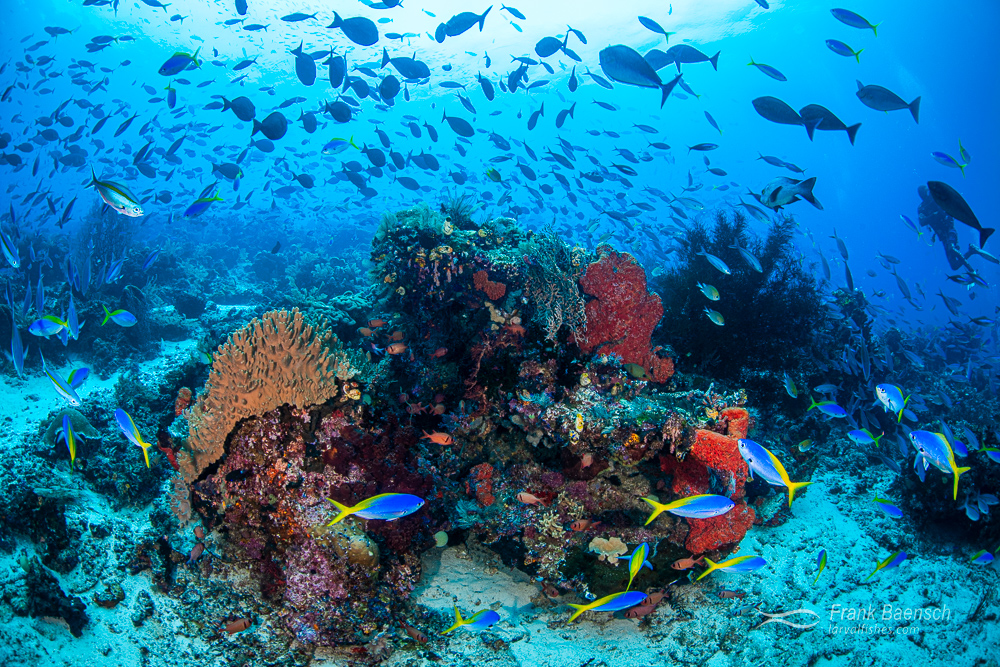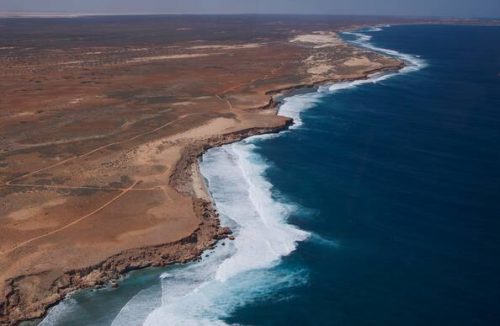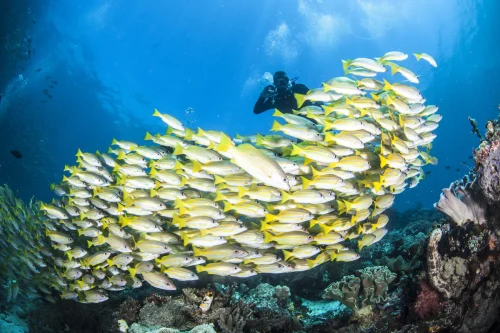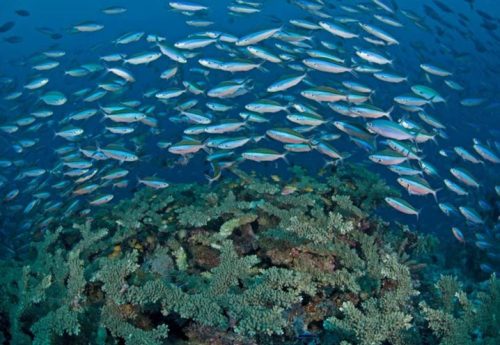Coral Reefs: Their Positive Impact on Social and Economic Development

Schools of surgeonfish and fusliiers swarm a colorful reef in Raja Ampat, Indonesia (Photo Credit : Frank Baensch)
Coral reefs are home to about 25% of all marine species. These ecosystems not only serve as life buffers for millions of marine species, but also play an important role in the carbon and nitrogen cycles, as well as oxygen production.
In an economic context, coral reefs make direct and indirect contributions to the global economy. Directly, they support the fishing and tourism industries. Coral reefs provide habitat for fish that feed millions of people and are also an attractive tourist attraction for divers and tourists. Indirectly, they play a role in protecting beaches from erosion and storm damage, which can have a major impact on infrastructure costs.
- Sustainable Tourism:
Healthy and sustainable coral reefs are the main attraction for tourism in many coastal destinations. Tourists from all over the world come to dive, snorkel, or simply enjoy the beauty of coral reefs. This creates significant economic opportunities for local communities, such as the opening of inns, restaurants, and other businesses that support the tourism sector.
By managing coral reefs sustainably, tourism can be a sustainable source of long-term income. This not only benefits local economies, but also aids in global conservation efforts by providing incentives to protect and restore coral reefs. Thus, sustainable tourism can create a balance between the utilization and preservation of coral reef ecosystems.
Ningaloo Coast
The Ningaloo Coast, located on Australia's remote west coast, encompasses 604,500 hectares of marine and land property, including one of the longest nearshore coral reefs in the world. On land, the site features an extensive karst system and a network of underground caves and streams. The annual gathering of whale sharks takes place on the Ningaloo Coast, which is home to a variety of marine species, including many sea turtles. The inland part of the site features underground water bodies with a large network of caves, channels, and groundwater streams. They support a wide range of rare species that contribute to the incredible biodiversity of marine and terrestrial sites.

Ningaloo Coast (Photo Credit : IUCN)
Raja Ampat
Raja Ampat is often considered one of the most beautiful seas in the world. One of the main reasons is the wealth of flora and fauna owned by Raja Ampat Marine Park. This region is also known to have one of the best coral reefs in Indonesia, with 540 species of hard coral, more than 1000 species of reef fish, 700 species of mollusks, and various unique species. Some of the species that can be found here include Dwarf Seahorses, Wobbegong, and Manta Rays, as well as some typical Raja Ampat fish such as Eviota Raja.

Top Coral Reef Locations in Indonesia (Photo Credit : Martin_Hristov/Shutterstock)
- Livelihood and Food Security:
Coral reefs are home to a variety of fish species and other marine organisms, which are important sources of livelihood and food security for coastal communities. Many of these communities depend on coral reefs for fish and other seafood, both for personal consumption and for sale at local markets.
Overfishing and unsustainable fishing can damage coral reef ecosystems and threaten these food supplies. Therefore, it is important to implement sustainable fishing practices and prudent management of marine resources. This can include restrictions on the type and number of fish that can be caught, as well as the use of environmentally friendly fishing technology.
By doing this, we can ensure that coral reefs remain healthy and productive, provide a stable food supply for local communities and strengthen food security in the region. In addition, by maintaining the health of coral reefs, we can also help maintain the overall balance of marine ecosystems, which are important for the well-being of our planet.

Photo Credit : darilaut.id
- Natural Beach Protection:
Coral reefs have an important role in protecting coastlines from erosion and damage from storms and ocean waves. They serve as natural barriers that dampen the force of ocean waves, thereby reducing the direct impact of waves on the coast. Thus, coral reefs help maintain shoreline stability and prevent soil erosion. This is especially important for coastal communities, where much of the infrastructure and human activity is near the coastline. In addition, coral reefs also help in the process of beach sand formation. Many dead coral organisms and shellfish destroyed by ocean waves end up becoming beach sand.
- Biodiversity Conservation:
Coral reef conservation efforts are critical to maintaining this biodiversity. Sustainable management approaches, such as fishing restrictions and protection of certain areas, can help maintain the health of coral reefs and the species they support. This not only helps save endangered species, but also maintains the balance of the marine ecosystem as a whole.
The benefits of coral reef conservation are not only felt by marine ecosystems, but also by humans. Healthy coral reefs support the fishing and tourism industries, protect coastlines from erosion, and even aid in climate change mitigation by absorbing carbon dioxide. Therefore, coral reef conservation efforts have long-term positive impacts on people and our planet.
Conclusion
Coral reefs have an inevitable positive impact on social and economic development. In addition to providing economic opportunities through the tourism sector, coral reefs also provide livelihoods, food security, coastal protection, and biodiversity conservation. It is important for all of us to preserve coral reefs and involve local communities in sustainable conservation efforts. Thus, we can ensure that the benefits of coral reefs will continue to be felt by future generations in sustainable social and economic development.

